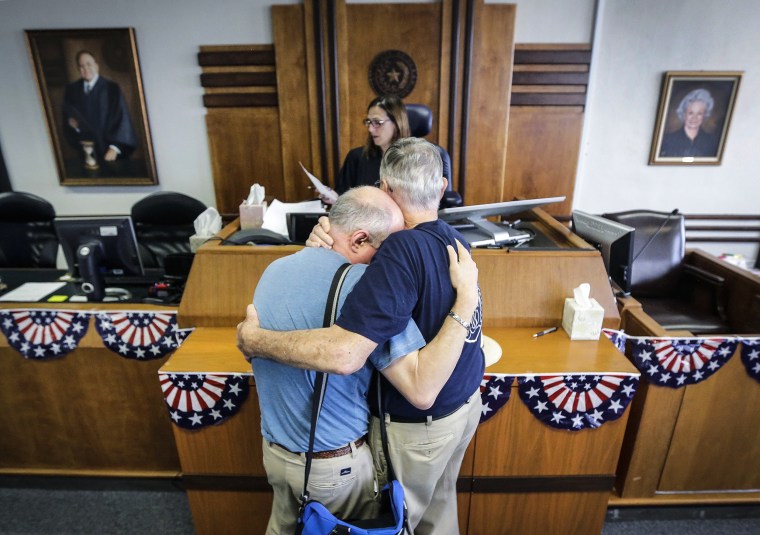The Union of Orthodox Jewish Congregations of America doesn’t support same-sex marriage. In fact, in its own words, its “religion is emphatic in defining marriage as a relationship between a man and a woman.” And that position is “unalterable.”
The Seventh-day Adventist Church shares a similar view, as does the National Association of Evangelicals and my own faith, The Church of Jesus Christ of Latter-day Saints. And yet, in recent weeks, members of Congress have publicly thanked these and other groups for their advice on amending the Respect for Marriage Act — a bill that would protect same-sex marriage under federal law.
I can think of few lines that better encompass that lesson of American politics than this: “You can’t always get what you want, but if you try, sometimes you might just find you get what you need.”
On Thursday, the House voted 258-169 in favor of the act, with 39 Republicans joining all the Democrats. The bill is now headed to President Joe Biden’s desk for a final signature.
This is a political victory for the LGBTQ community, but it’s also a win for pluralism — and the foundational principle that groups with differing views can find a way to compromise and move forward together. In an age of extreme partisanship and rigid group delineations, this victory shows that not all is lost. It demonstrates that the American model of representative democracy — though riddled with divisions — can still address complex contemporary issues.
This victory was achieved because the Respect for Marriage Act also includes important principles of religious freedom for those who don’t endorse same-sex marriage itself. While the measure repeals the Defense of Marriage Act and ensures same-sex marriages can’t be denied by any person “acting under color of State law,” the act also protects churches and religious organizations from being forced to perform gay weddings or provide services for celebrations that go against their faith’s teachings.
Additionally, the bill is explicit in not affecting the tax-exempt status of churches or religious schools, and it doesn’t “diminish or abrogate” any religious freedom protections already provided under existing federal law and the Constitution. Finally, the bill acknowledges that traditional views on marriage are “held by reasonable and sincere people based on decent and honorable religious or philosophical premises.”
This last point is particularly important. As Yale law professor William Eskridge, a long-time advocate of gay marriage, told me, those with traditional attitudes toward marriage have felt social pressure to move into their own closets regarding their faith-based views.
“I don’t think people should feel like they can’t express their deeply held religious beliefs publicly,” said Eskridge, who is gay and an avowed Presbyterian. “I support the religious allowances. Churches shouldn’t be bullied.”
Rev. Marian Edmonds-Allen, the executive director of Parity, a nonprofit group that engages both religious and LGBTQ communities, said the effort behind the Respect for Marriage Act should offer a model for resolving other intractable issues.
“This is a win for my family, but it’s also a tremendous win for religious freedom and a watershed moment for political cooperation,” she told me. “People who want bipartisan solutions should look at this model and emulate it.”
Sadly, not everyone is enthusiastic. On the right, criticism has largely centered on calling for even stronger religious freedom amendments or strenuously objecting to the inclusion of same-sex marriage in any federally codified definition of marriage.
On the left meanwhile, some LGBTQ advocates have already said the measure doesn’t go far enough. They are calling on Congress to advance the Equality Act, which aims to prohibit discrimination based on sex, sexual orientation, gender identity and intersex status, but is largely devoid of robust religious freedom provisions.
It’s true that these two factions didn’t receive all they wanted. But they are overlooking the more important things they did get: protections that might not have been possible without some level of cooperation from the other side, and reinforcement that the government can enshrine the most important principles in law.
The United States was founded on the hope that disagreement — even “ferocious disagreement,” as historian Jon Meacham put it — could be channeled into compromise and reciprocity.
As founding father James Madison famously observed, American society will have “so many parts, interests, and classes of citizens, that the rights of individuals, or of the minority, will be in little danger from interested combinations of the majority.” In other words, if everyone is a little guy, there’s a majority interest in looking out for the little guy. Madison continued that civil rights are protected in part because of this “multiplicity of interests” and, in a similar way, religious rights are protected by a “multiplicity of sects.”
On the one hand, these diverse interests make sweeping political victories unlikely, which should breed a sense of political modesty. On the other hand, that should also foster a sense of security. While it’s not likely that one interest group will win outright under this political arrangement, it’s also far less feasible for one interest group to trample the interests of another.
This, Madison argues, is a feature of the American system, not a bug.
Political modesty, alas, rarely rallies donors or drives voter turnout. But over time, the model of political pluralism embodied in the Respect for Marriage Act can help renew national trust. When political opponents are no longer existential threats, we start to see how they might actually be partners in protecting reciprocal rights.
Though penned by the British, I can think of few lines that better encompass that lesson of American politics than this: “You can’t always get what you want, but if you try, sometimes you might just find you get what you need.” If passage of the Respect for Marriage Act accomplishes little else than reminding us of these truths, it will have served the country well.
